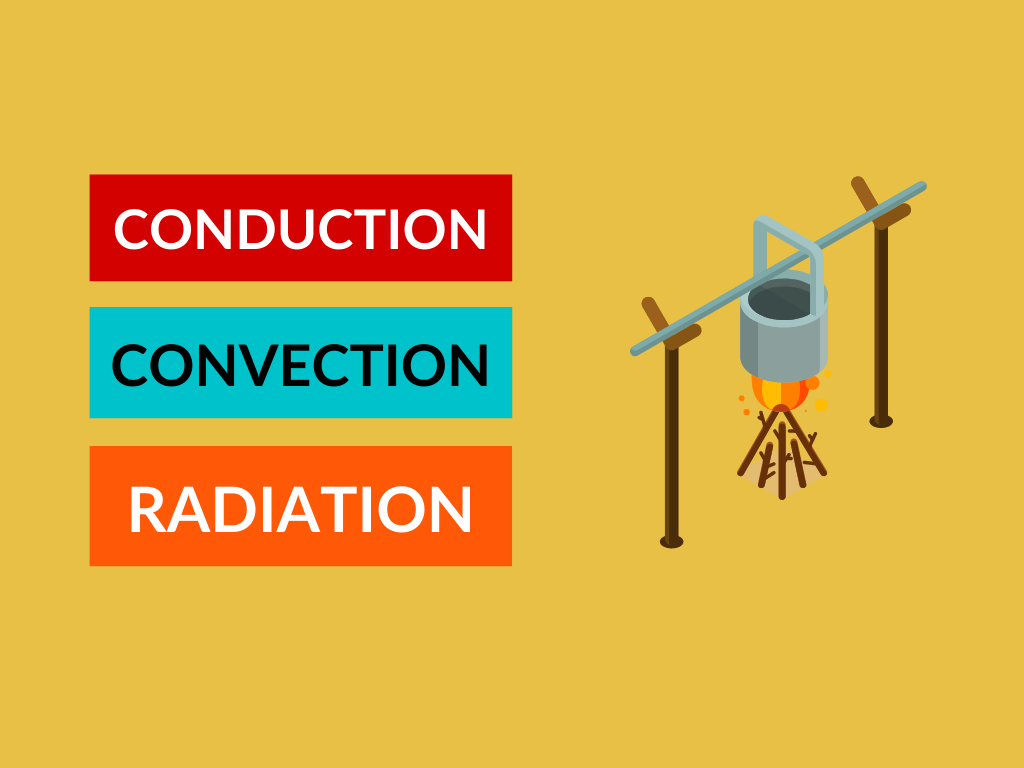When we want to discuss the Difference between Conduction Convection and Radiation all these factors are related to the transfer of heat. Conduction is the process of transfer of heat through direct contact. Convection is a mode of heat transfer that involves the movement of molecules. Radiation is a mode of heat transfer that occurs through electromagnetic waves


What is Conduction?
Conduction is the process of transfer of heat through direct contact of matter due to the temperature gradient. The mode of heat transfer is very common in solids and negligible in liquids. The heat transfer moves from one particle to another while the substance remains idle. The mode of heat transfer occurs in homogeneous non-conductive hard bodies.
In simple terms, whenever two objects are in direct contact with one another, there will be a transfer of heat from the hotter object to the colder one, which is due to conduction. Further, the objects which permit heat to travel easily through them are called conductors. Occurs in solids, through molecular collisions. It Uses a heated solid substance for transfer. It is caused due to the temperature difference. It is a slow process. It Does not follow any law of reflection or refraction.
Examples of the situation with conduction:
- Touching a stove when it is lit
- Feeling the coolness from the ice cubes
- Boiling water by thrusting a red-hot piece of iron into it
What Is Convection?
Convection is a mode of heat transfer that involves the movement of molecules from a hot temperature to a cool temperature. The heat transfer mode is quite common in fluids. The mode of heat transfer occurs naturally or can even be forceful. Natural convection is controlled by gravity.
Gravity has a great role to play in natural convection such that when the substance is heated from below, leads to the expansion of the hotter part. Due to buoyancy, the hotter substance rises as it is less dense and the colder substance replaces it by sinking at the bottom, due to high density, which when gets hot moves upward, and the process continues. In convection, on heating up the substance, its molecules disperse and move apart.
Examples of situations with convection:
- Sometimes we observe changes in the air, sometimes it is hot when the temperature is high and sometimes it is cool when it is likely to rain.
What Is Radiation?
Radiation is a mode of heat transfer that occurs through electromagnetic waves without involving any medium. The heat does not require any physical contact for the flow of particles to be transmitted. However, the mode of heat transfer follows the law of reflection and the law of refraction. It normally occurs due to a slight increase in temperature. It happens in all states of matter.
Whenever you feel the heat without actually touching the object, it is because of radiation. Moreover, color, surface orientation, etc. are some of the surface properties on which radiation depends greatly.
In this process, the energy is transmitted through electromagnetic waves called radiant energy. Hot objects generally emit thermal energy to cooler surroundings. Radiant energy is capable of traveling in the vacuum from its source to the cooler surroundings.
Examples of situations with radiations:
- The heat from the sun warming your face
- The heat from a lightbulb
- The heat from a fire
Difference between Conduction Convection and Radiation
| CONDUCTION | CONVECTION | RADIATION |
|---|---|---|
| Conduction explains the process in which the transfer of heat takes place between objects by direct contact. | Convection refers to the form of heat transfer in which energy transition occurs within the fluid. | Radiation helps in the mechanism by which heat is transmitted without any physical contact between objects. |
| Representation | ||
| Conduction helps the heat to travel between objects in direct contact. | Convection helps the heat to pass through fluids. | Radiation helps the heat to flow through empty spaces. |
| Occurrence | ||
| Occurs in solids, through molecular collisions. | Occurs in fluids, by the actual flow of matter. | Occurs at a distance and does not heat the intervening substance. |
| Transfer of heat | ||
| It Uses a heated solid substance for transfer. | It Uses an intermediate substance. | It Uses electromagnetic waves. |
| Cause | ||
| It is caused due to the temperature difference. | It causes due to the difference in density | It occurs from all objects, at a temperature greater than 0 K. |
| Speed | ||
| It is a Slow process | It is a Slow process | It is a fast process |
| Law of reflection and refraction | ||
| It Does not follow any law of reflection or refraction | It Does not follow any law of reflection or refraction | It follows the law of reflection or refraction |
| Examples | ||
| 1.Touching a stove when it is lit 2.Feeling the coolness from the ice cubes 3.Boiling water by thrusting a red-hot piece of iron into it | Sometimes we observe changes in the air, sometimes it is hot when the temperature is high and sometimes it is cool when it is likely to rain. | 1.The heat from the sun warming your face 2.The heat from a lightbulb 3.The heat from a fire 4.The heat from anything else is warmer than its surroundings. |
Conclusion
Thermodynamics is the study of heat transfer and the changes related to it. Conduction is nothing but the heat transfer from the hotter part to the colder one. Convection is the heat transfer by the up and down motion of the fluid. Radiation occurs when heat travels through empty space.https://www.youtube.com/watch?v=HpCvWuvCUoA



